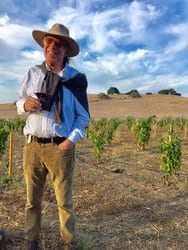
Popelouchum
San Benito County

Popelouchum: Reimagining Wine from the Ground Up
Founding Vision: Radical Roots in Ancient Soil
Popelouchum (pronounced po-puh-LOH-shoom), meaning "paradise"
in the language of the Mutsun people, is the most ambitious project yet from
iconoclast Randall Grahm. Established in 2012 near San Juan Bautista, the
410-acre estate pushes beyond traditional viticulture. Grahm's vision isn't to
imitate great wines of the past, but to create entirely new
expressions—new grape varieties, new relationships with soil, and ultimately,
new wines that are deeply of place and genetically original.
Farming with Purpose: Regenerative Methods, Genetic
Diversity
The estate is farmed regeneratively, emphasizing biodiversity and soil
health—but its most radical innovation is in how vines are created.
Rather than cloning existing varieties, Grahm is cultivating vines from seed.
His two main approaches:
- Varietal Auto-Tuning: Self-pollinating biotypes like Sérine Syrah to create genetically distinct siblings, planted together to express a broad spectrum of complexity.
- Traditional Crossbreeding: Breeding up to 10,000 new grape varieties, using parents like Ciliegiolo and Picolit. These are planted on diverse soils to let terroir, rather than variety, shape the wine.
This re-centers wine identity from grape variety to soil expression, potentially reshaping the future of viticulture.
The Vineyard Landscape: Soil-Driven Identity
Bordering the San Andreas Fault, Popelouchum sits atop one of California's most
geologically diverse sites. With four major, distinct soil types across the
property, Grahm has inverted the traditional model: planting varied grapes on
each soil, observing how place shapes flavor in the absence of varietal
sameness. Each 2.5-acre block becomes a lens into how terroir asserts itself
when freed from varietal expectation.
Winemaking with Inquiry: Minimalist Technique, Maximal
Expression
While the breeding project matures, wines are already produced from traditional
varieties. As expected, Grahm's methods defy convention—fermentations with wild
yeast, aging in amphorae, and site-specific approaches all aim to let the land
speak clearly. These early wines are vivid, surprising, and unapologetically
expressive of Popelouchum's unique soils.
Conclusion: A Vineyard Unlike Any Other
Popelouchum isn't just a vineyard—it's a bold rethinking of what wine can be.
By blending scientific experimentation with deep respect for the land, Randall
Grahm has created a living laboratory of terroir and possibility. The wines
here won't just reflect a place—they may well redefine it.
Your pdf has been sent with success.